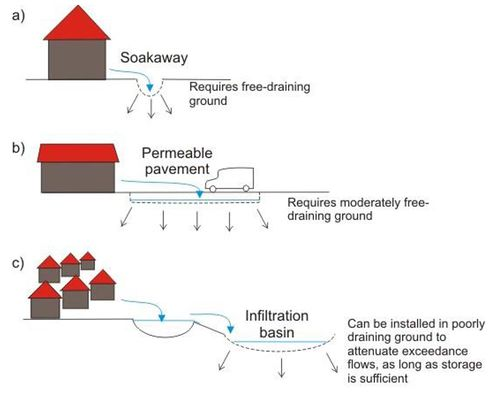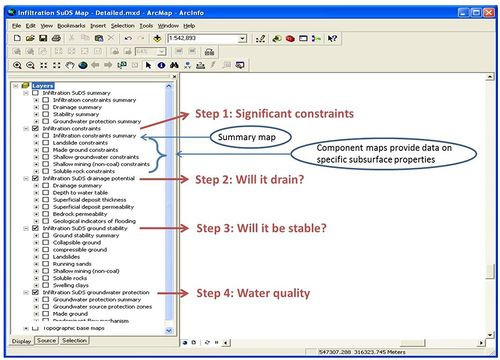OR/16/009 About the infiltration SuDS map
| Dearden, R. 2016. User guide for the infiltration SuDS map: detailed. British Geological Survey Internal Report, OR/16/009. |
Background
Following extensive flooding in 2007 across much of the UK, the Government launched a review to determine the causes and consequences of the flood events and to establish the most appropriate course of action to reduce future flooding (Pitt, 2008[1]). The review found that intense rainfall and overland flow on impervious surfaces resulted in flooding particularly in urban areas where the piped drainage networks were overwhelmed. The impacts were not restricted to flooding; storm water flow through combined sewers (that carry both foul and surface water) overflowed to watercourses during storm events, resulting in a deterioration of water quality. To reduce the intensity and magnitude of such impacts during flood events, the review recommended that our reliance on the existing piped drainage network should be decreased. The recommendations were further considered in the Making Space for Water strategy (DEFRA, 2005[2]) and were then enacted to law by the Floods and Water Management Act 2010 (HMSO, 2010[3]).
One of the recommendations, enacted to law via Schedule 3 of the Floods and Water Management Act, was the specific provision for the implementation of sustainable drainage systems (SuDS) in all new developments (excluding single dwellings). To promote the use of SuDS, the Act withdraws Section 106 of the Water Industry Act 1991, thereby removing the automatic right for developers to connect to the drainage network (HMSO, 2010[3]). An exception applies to single dwellings, which are excluded from this requirement in law. However, even for single dwellings, there are significant advantages to using SuDS in practice, for example they require reduced drainage infrastructure and attract disconnection rebates for homeowners.
Sustainable drainage aims to reduce the reliance on traditional piped drainage networks by draining surface water in a way that mimics the natural water cycle, thereby decreasing flow rates and reducing peak flows to rivers. In addition, SuDS remove pollutants near to source and thereby play a key role in improving catchment water quality. Benefits for amenity and biodiversity are also associated with installing SuDS instead of traditional drains (Woods-Ballard et al., 2007[4]).
Sustainable drainage includes surface water management techniques such as:
- rainwater re-use (water butts, rainwater harvesting systems)
- rainwater storage with discharge to watercourses (detention basins/ponds/subsurface chambers), and
- infiltration to the ground (soakaways, infiltration basins, permeable pavements)
Systems often incorporate two or more SuDS techniques connected in series. This enables an incremental reduction in pollutants, flow rates and volumes along the drainage flow path. The connection of systems in this way is termed the management train.
The design, construction, operation and maintenance of SuDS have been the subject of numerous documents since the release of the draft SuDS National Standards (DEFRA, 2011[5]). Since then, the standards have become focused on controlling the rate and quantity of flow (DEFRA, 2015[6]). The National Planning Policy Framework has published further Planning Practice Guidance that supports sustainable drainage and suggests the following order of preference for the runoff destination:
- discharge to the ground
- discharge to a surface water body
- discharge to a surface water sewer
- discharge to a combined sewer
To determine whether SuDS that infiltrate to the ground are compatible with the subsurface, the ground conditions at each individual site need to be assessed.
The British Geological Survey has developed two series of maps that provide information on the suitability of the subsurface for infiltration SuDS:
- a. Infiltration SuDS Map: Summary
- b. Infiltration SuDS Map: Detailed
The Infiltration SuDS Map: Summary comprises of four maps that provide an overview of ground suitability for infiltration SuDS. It does not provide any information about the properties of the subsurface. It is purely intended as a dataset for strategic planning.
This user guide describes the Infiltration SuDS Map: Detailed. This map comprises the four summary layers included within the Infiltration SuDS Map: Summary, plus an additional twenty data layers, containing a wealth of subsurface property information that can be used to make a preliminary assessment of the suitability of the subsurface for infiltration SuDS.
| The Infiltration SuDS Map: Detailed provides data that will enable a preliminary assessment of the subsurface for infiltration SuDS. The Infiltration SuDS Map facilitates efficient and scientifically The map is not a replacement for a soakaway test or site investigation. |
What are infiltration SuDS?
Infiltration SuDS is a term that covers a number of infiltration techniques including:
- soakaways
- infiltration trenches
- infiltration basins
- permeable pavements
- wetlands
- unlined ponds, and
- unlined swales
These systems facilitate the infiltration of surface water into the ground. Once in the ground, the water percolates through the subsurface to the groundwater.
Infiltration SuDS are appropriate in a wide variety of ground conditions, but the design must be compatible with the properties of the subsurface, in particular, the infiltration rate. Infiltration SuDS are commonly installed within freely draining ground, but they can also be used in less permeable deposits, if they are designed to incorporate larger infiltration areas (e.g. permeable pavements), or the capacity to store water (e.g. infiltration basins). By increasing the surface area or volume of the infiltration system, the amount of water infiltrated and the time over which infiltration can occur are increased. This allows infiltration SuDS to be installed in ground that would not otherwise be suitable for the installation of soakaways. In such ground conditions, infiltration may not provide the whole drainage solution, but may form part of the drainage strategy alongside SuDS that store and re-use water.
Figure 1 illustrates three types of infiltration SuDS and Table 1 summaries the characteristics of infiltration SuDS in terms of typical storage capacity, surface area for infiltration, pollutant attenuation capacity, land take requirement, and amenity value.

| Technique | Description | Typical storage capacity | Surface area for infiltration | Pollutant attenuation capacity | Land-take requirements | Amenity value |
| Infiltration basin | Comprises a depression in the ground, where water can be stored during gradual infiltration through the permeable base | High | Moderate to high | Medium to high | High, but dual use possible | Potentially high |
| Infiltration trench | Comprises a gravel-filled trench with a permeable base through which water can infiltrate the ground | Moderate | Moderate | Low to high | Low | Low |
| Permeable pavement | A durable permeable surface, through which water can infiltrate. Systems may allow infiltration directly to the ground, or may be constructed with a subbase providing storage capacity, allowing more gradual infiltration to the ground | Low to high | Low to high | High | High, but dual use normal | Potentially high |
| Soakaway | Metre-scale pit in the ground, that stores water during gradual infiltration | Low to moderate | Low to moderate | Low to medium | Low | Low |
| Wetland | Comprises a natural or man- made swampy or boggy area with a permeable base | Moderate | Moderate to high | Medium to high | High | Potentially high |
Who might require this map?
The Infiltration SuDS Map developed by BGS is relevant to professionals who make decisions on SuDS design, construction, and approval. The maps will help:
- make preliminary decisions on the suitability of the subsurface for infiltration SuDS
- make preliminary decisions on the type of infiltration SuDS that will likely be appropriate
- assess SuDS planning applications to determine whether the necessary factors have been considered
- determine whether infiltration SuDS could be appropriate where a non-infiltrating SuDS technique has been proposed
The dataset is relevant to professionals throughout construction, including those involved with planning, land surveying, architecture, landscape design, construction, SuDS design, SuDS approval and regulation. It may also be of interest to solicitors, loss adjusters, and the insurance industry.
About the dataset
The Infiltration SuDS Map: Detailed comprises a GIS in four thematic sections, which together provide answers to four key questions.
The intention is that the user will work through these questions sequentially, using the data included in the map to guide decisions. For each question, a summary map provides an overview of the subsurface properties, whilst multiple component data layers provide more detailed information about the subsurface characteristics. Figure 2 illustrates the form of the summary and component data layers within the GIS.

The four questions are:
Question 1. Are there any constraints that mean infiltration SuDS should only be used if the potential for, and consequences of flooding and geohazards are known?
This step addresses the potential presence of geological and hydrogeological hazards that could be initiated or worsened by infiltrating water to the ground. In such areas, infiltration is not recommended unless a full appraisal of the potential for and consequences of infiltration has been undertaken. Possible hazards include:
- ground instability resulting from the infiltration of water into rocks that are highly susceptible to landslide or collapse associated with dissolution or shallow mining;
- flooding resulting from infiltration into deposits where the water table is shallow and potentially able to rise causing inundation of soakaways or emergence of groundwater at the ground surface, and
- made ground of unknown characteristics that may be unstable or potentially contaminated.
Question 2. What is the drainage potential of the subsurface?
The drainage potential of the ground depends on the geology and hydrogeology of the subsurface. This step provides information on the depth to water table, the permeability of superficial deposits, the thickness of superficial deposits and the permeability of the bedrock. Data are also provided on the presence of deposits that lie on a floodplain; in such deposits, groundwater level may respond rapidly to rises in river level causing inundation of subsurface systems.
Question 3. Are there any ground stability considerations?
Not all ground instability hazards will preclude the installation of infiltration SuDS, but if present, those hazards should be taken into account during design and construction. Where such hazards are thought to be present, they are highlighted in this step. Hazards considered include soluble rocks, landslides, compressible ground, collapsible ground, shrink-swell clays, running sand, and shallow mining (excluding coal mining).
Question 4. Is the groundwater susceptible to deterioration in quality?
When designing SuDS installations the potential impact on groundwater quality should be considered. This step provides information on the Environment Agency, and Natural Resources Wales source protection zone classification, the predominant flow mechanism through the unsaturated zone and on the presence of made ground, which may be contaminated. This information can be used, in part, to determine likely pre-treatment requirements.
The dataset is intended to provide the information required to make a preliminary decision on the extent to which the subsurface at a site is suitable for the installation of infiltration SuDS. The data is NOT an alternative for a site investigation or an infiltration test.
References
- ↑ PITT, M. (2008) Pitt Review: Learning lessons from the 2007 floods, HM Government.
- ↑ DEFRA (2005) Making space for water: Taking forward a new Government strategy for flood and coastal erosion risk management in England, Department for Environment, Food and Rural Affairs, PB10516.
- ↑ 3.0 3.1 HMSO. 2010. Floods and Water Management Act, Chapter 29, HM Government, Her Majesty's Stationery Office.
- ↑ 4.0 4.1 WOODS-BALLARD, B, KELLAGHER, R, MARTIN, P, JEFFERIES, C, BRAY, R, and SHAFFER, P. 2007. The SUDS Manual. CIRIA, RP697.
- ↑ DEFRA. 2011. National Standards for sustainable drainage systems (draft). H M Government (London).
- ↑ DEFRA. 2015 Sustainable Drainage Systems. Non-statutory technical standards for sustainable drainage systems. DEFRA. March 2015.